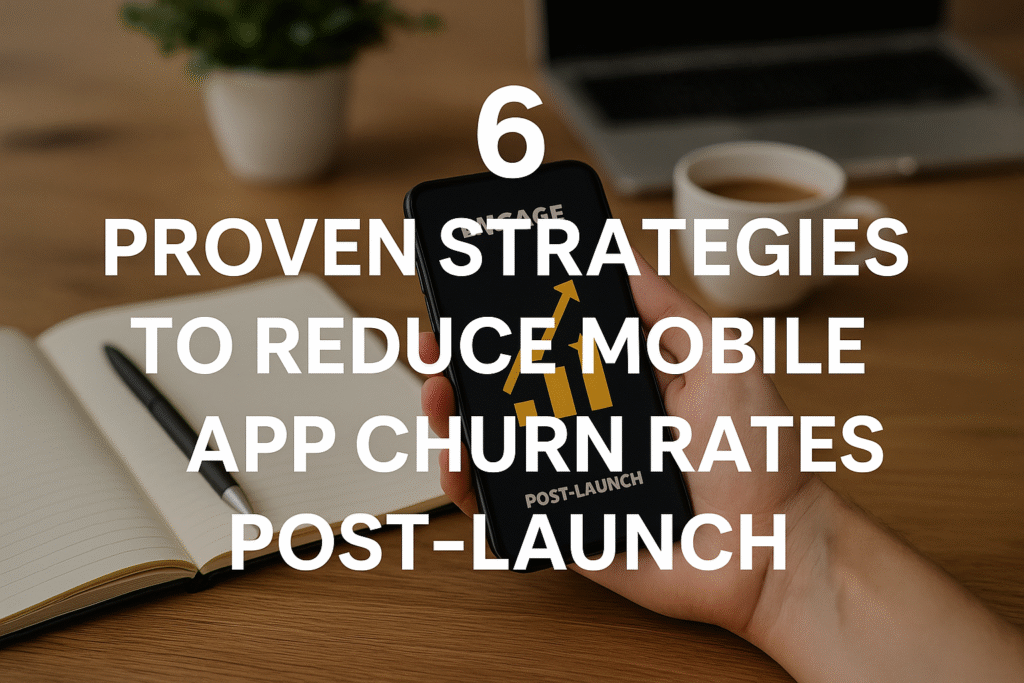
In the fiercely competitive mobile app market, acquiring new users is only half the battle; retaining them is the real challenge. Mobile app churn rate – the percentage of users who stop using an app over a given period – is a critical metric that directly impacts an app’s long-term viability and profitability. A high churn rate can quickly negate the effort and investment in user acquisition, turning a promising app into a fleeting trend.
For any Mobile App Development Company, focusing on reducing churn post-launch is paramount. It’s significantly more cost-effective to retain an existing user than to acquire a new one. By understanding why users leave and implementing targeted strategies to enhance their long-term engagement, app developers can build a loyal user base, foster positive word-of-mouth, and secure sustainable growth.
Here are 6 proven strategies to reduce mobile app churn rates post-launch:
1. Optimize the Onboarding and First-Run Experience
The initial moments with your app are crucial; they set the stage for long-term engagement or immediate abandonment.
- Strategy Explained: A user’s decision to stay or leave an app is often made within the first few minutes, or even seconds. An optimized onboarding process should be concise, intuitive, and immediately demonstrate the app’s core value. This involves:
- Show, Don’t Tell: Instead of lengthy tutorials, allow users to experience key features firsthand. Use visual cues and progressive disclosure to guide them.
- Highlight Core Value: Immediately showcase what makes your app indispensable. What problem does it solve for the user?
- Keep It Brief: Minimize required sign-up fields or permissions. Only ask for what’s absolutely necessary at that moment.
- Personalization Options (Early): Offer quick ways for users to tailor their experience if relevant, making the app feel more personal from the start.
- Success Celebration: Acknowledge when a user completes the onboarding or their first task successfully, providing positive reinforcement.
- Why it Reduces Churn: A seamless and valuable first impression significantly increases the likelihood that a user will explore the app further and integrate it into their routine. Confusing, lengthy, or uninspiring onboarding is a primary reason for early churn. It sets the foundation for habit formation.
- Mobile App Development Company Focus: Invest heavily in UX research and A/B testing for your onboarding flow. Utilize analytics to track drop-off points during the first-run experience. Continuously iterate based on user feedback and engagement data from early cohorts.
2. Implement Deep Personalization and Adaptive Content
Make the app feel uniquely tailored to each individual user.
- Strategy Explained: Generic experiences quickly lead to disinterest. Modern users expect apps to understand their preferences, behaviors, and evolving needs. Leveraging AI and machine learning, apps can provide:
- Content Recommendations: Tailoring feeds, products, articles, or media based on past interactions, expressed interests, and even contextual data (time, location).
- Adaptive Interfaces: Dynamically adjusting the UI layout or highlighting features based on user usage patterns and preferences.
- Personalized Notifications: Delivering timely and relevant messages that align with individual user habits and stated preferences (e.g., a fitness app reminding a user about their favorite workout on their usual gym day).
- Contextual Assistance: Providing help or suggestions based on the user’s current activity within the app.
- Why it Reduces Churn: When an app consistently delivers relevant and valuable content or features, it becomes indispensable. Personalization fosters a deeper connection with the user, making the app feel more intuitive and valuable, thus increasing perceived utility and reducing the likelihood of users seeking alternatives.
- Mobile App Development Company Focus: Build robust data analytics capabilities to capture and interpret user behavior. Integrate machine learning models for recommendation engines and predictive analytics. Design flexible UI components that can adapt dynamically to personalized content and layouts. Ensure ethical data usage and transparency.
3. Proactive Engagement and Smart Notifications
Communicate thoughtfully and strategically to re-engage users.
- Strategy Explained: Not all communication is good communication. To reduce churn, notifications and in-app messages must be timely, relevant, and provide clear value, rather than being a nuisance. This involves:
- Segmented Push Notifications: Sending targeted messages to specific user segments based on their behavior, demographics, or inactivity (e.g., a reminder to a user who hasn’t opened the app in a week, offering a new feature they might like).
- In-App Messaging: Providing contextual help, tips, or prompts directly within the app when a user is performing a specific action or seems stuck.
- Email Campaigns: Beyond push notifications, well-crafted email sequences can re-engage dormant users with updates, new features, or exclusive content.
- “Win-back” Campaigns: Specific strategies for users who have churned, offering incentives or highlighting recent improvements that might encourage them to return.
- Why it Reduces Churn: Strategic engagement keeps the app top-of-mind and reminds users of its value. Personalized and timely messages can prevent users from drifting away by addressing potential pain points or highlighting new reasons to return. Overuse or irrelevant notifications, however, can lead to immediate uninstalls.
- Mobile App Development Company Focus: Implement a sophisticated CRM (Customer Relationship Management) system or a dedicated mobile engagement platform. Utilize AI to optimize notification timing and content. Continuously A/B test different messaging strategies to identify what resonates best with various user segments.
4. Listen to User Feedback and Iterate Rapidly
Show users their voices matter and continuously improve the app.
- Strategy Explained: Actively seeking, analyzing, and responding to user feedback is crucial for identifying pain points and driving meaningful improvements. This includes:
- In-App Feedback Channels: Easy-to-find options for users to report bugs, suggest features, or provide general comments (e.g., feedback forms, rating prompts at non-disruptive moments).
- App Store Reviews: Monitoring and responding thoughtfully to reviews on Google Play and Apple App Store.
- User Surveys & Interviews: Conducting qualitative and quantitative research to understand user sentiment and needs.
- Analytics & Crash Reporting: Proactively identifying performance issues, crashes, and usage patterns that indicate frustration.
- Rapid Release Cycles: Regularly pushing updates that address reported issues, introduce requested features, and improve overall performance.
- Why it Reduces Churn: Users feel valued and heard when their feedback leads to visible improvements. This fosters a sense of community and investment in the app’s evolution. Addressing bugs and implementing requested features directly improves the user experience, eliminating reasons for abandonment and turning frustrated users into loyal advocates.
- Mobile App Development Company Focus: Establish clear feedback loops from users to the development team. Prioritize bug fixes and user-requested features in your roadmap. Communicate transparently about updates and how user feedback influenced them (e.g., in release notes or in-app announcements).
5. Leverage Gamification and Reward Systems (Beyond Basics)
Incentivize continued engagement and habit formation with meaningful rewards.
- Strategy Explained: While points and badges are a start, deeper gamification strategies can significantly boost retention. This involves:
- Progress Tracking & Visuals: Clearly showing users their journey and progress within the app (e.g., skill trees, level systems, animated progress bars).
- Streaks & Milestones: Encouraging consistent daily engagement by rewarding streaks (e.g., consecutive logins, daily task completion) and celebrating significant milestones.
- Meaningful Challenges & Quests: Framing app usage as engaging challenges that provide a sense of accomplishment and progression.
- Virtual Economies: Allowing users to earn in-app currency for actions, which can then be spent on desirable customizations or premium features.
- Social & Collaborative Elements: Integrating features that allow users to compete with friends, collaborate on goals, or share achievements.
- Why it Reduces Churn: Gamification taps into human psychology, leveraging desires for achievement, mastery, social connection, and progression. It makes app usage more enjoyable, habit-forming, and intrinsically motivating, providing reasons to return beyond just utility.
- Mobile App Development Company Focus: Design gamified elements that align with the app’s core purpose and target audience. Ensure rewards are genuinely desirable and integrated seamlessly into the UX. Continuously monitor the effectiveness of gamification elements and adjust based on engagement data.
6. Prioritize Performance Optimization and Bug Fixing
A slow, buggy app will inevitably lead to user frustration and abandonment.
- Strategy Explained: Technical performance is a foundational aspect of user experience. Users expect apps to be fast, responsive, and stable. This strategy focuses on continuous technical excellence:
- Speed & Responsiveness: Optimizing load times, reducing lag, and ensuring smooth animations and transitions.
- Stability & Crash Prevention: Rigorous testing, robust error handling, and prompt bug fixes to minimize crashes and unexpected behavior.
- Resource Management: Ensuring the app doesn’t drain battery excessively or consume too much data or storage.
- Offline Functionality: Where applicable, providing a seamless experience even without an internet connection to maintain utility.
- Regular Updates: Consistently pushing updates that include performance enhancements and bug fixes.
- Why it Reduces Churn: Frustration stemming from slow performance, frequent crashes, or excessive resource consumption is a major churn driver. A reliable and performant app fosters trust and confidence, making users more likely to incorporate it into their daily routines. Technical excellence is the bedrock upon which all other engagement strategies are built.
- Mobile App Development Company Focus: Implement continuous integration and continuous delivery (CI/CD) pipelines for rapid testing and deployment. Utilize performance monitoring tools (APM – Application Performance Management) to identify bottlenecks. Prioritize critical bug fixes immediately. Allocate dedicated resources for ongoing maintenance and optimization.
In conclusion, while user acquisition is vital, true success for any Mobile App Development Company hinges on its ability to retain users post-launch. By strategically implementing a combination of these 6 proven strategies—from a stellar first impression and deep personalization to proactive engagement, responsive feedback loops, smart gamification, and unwavering technical excellence—apps can transform casual users into loyal advocates, significantly reducing churn rates and building a sustainable path to long-term growth and profitability.







